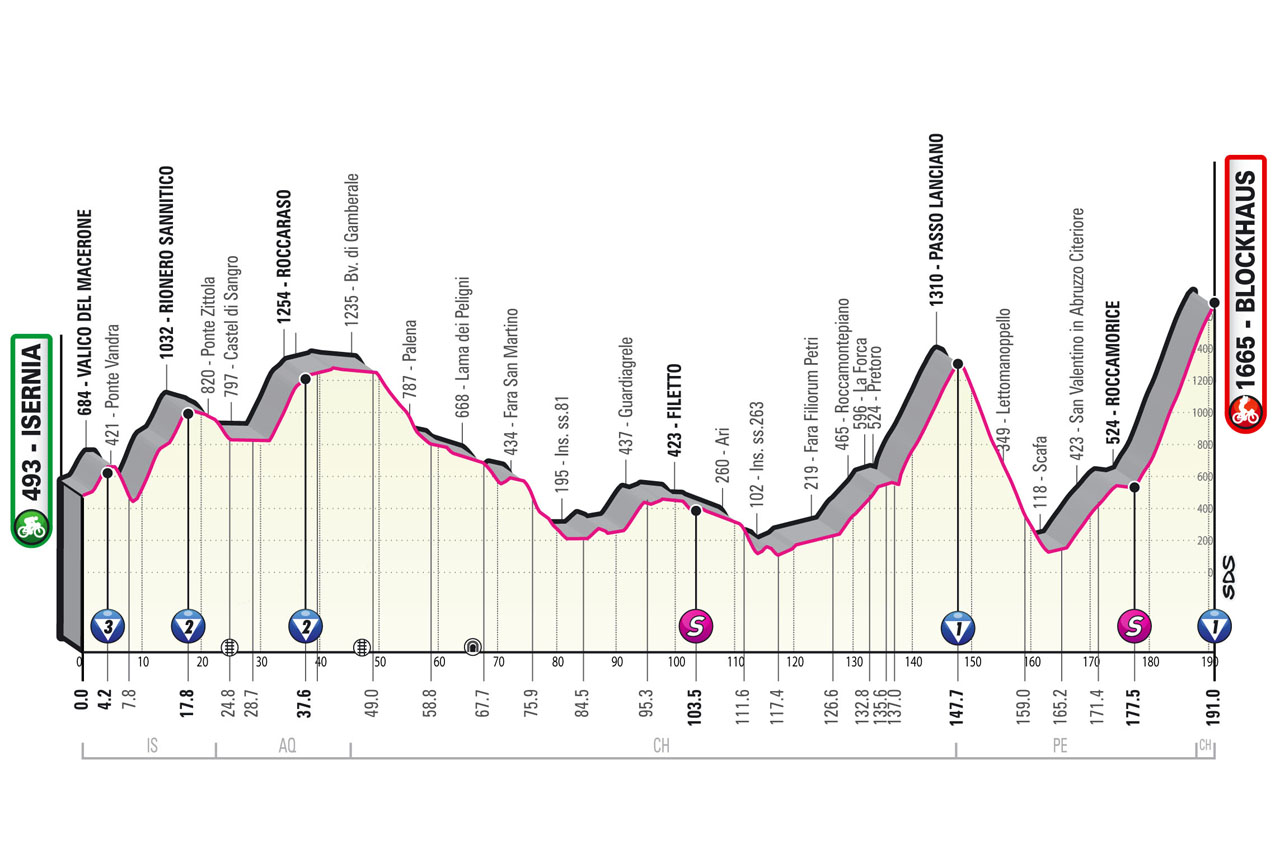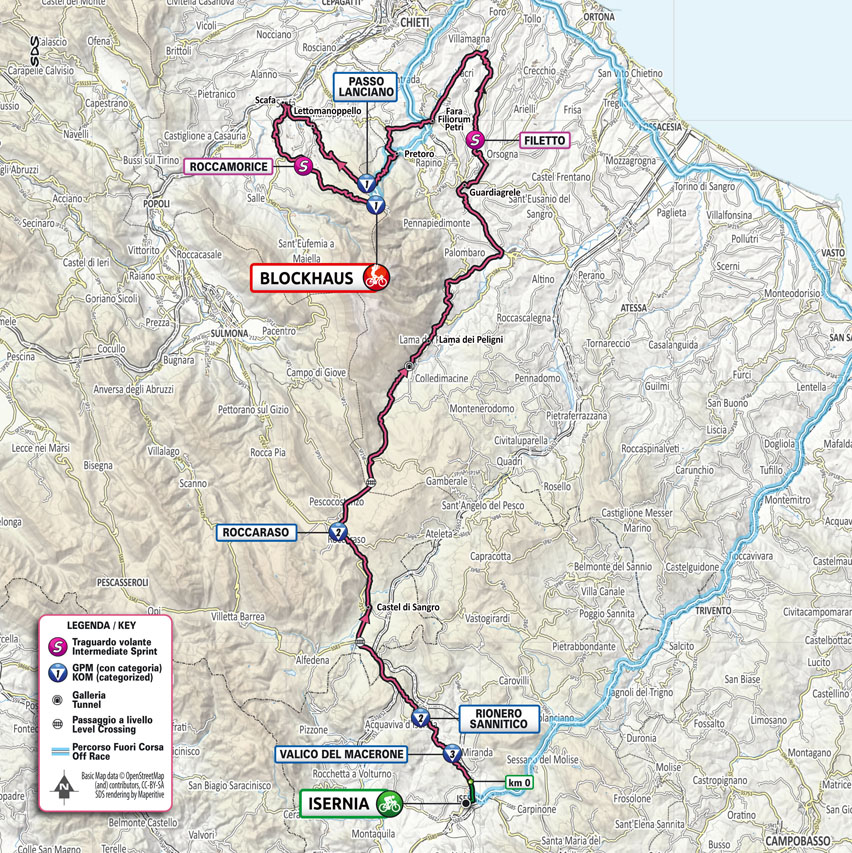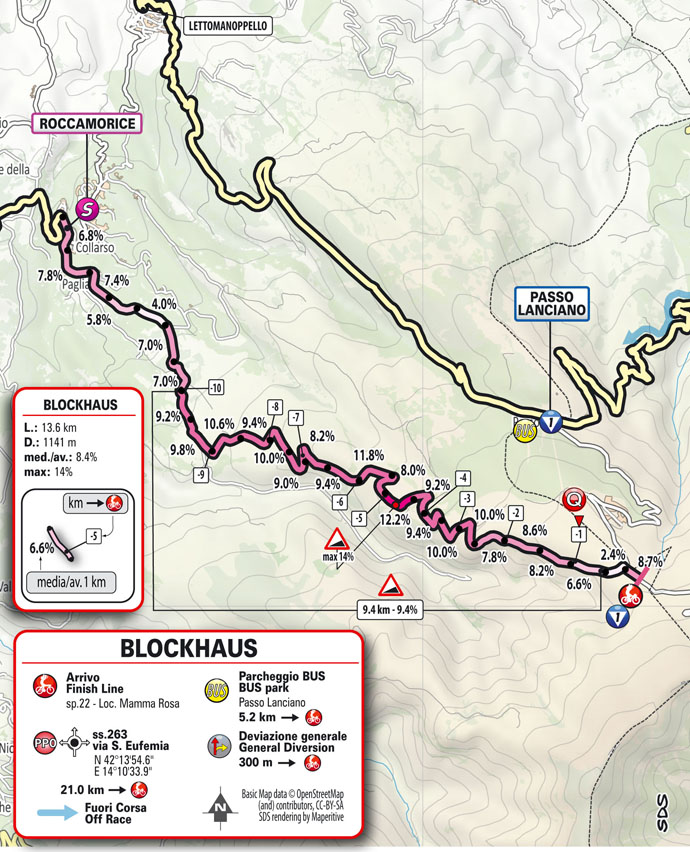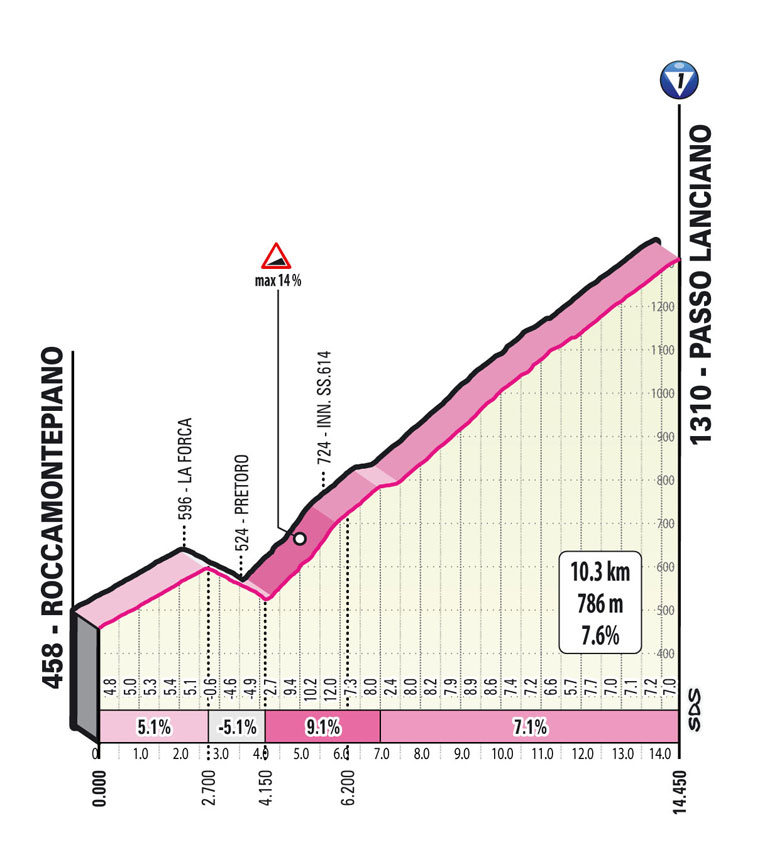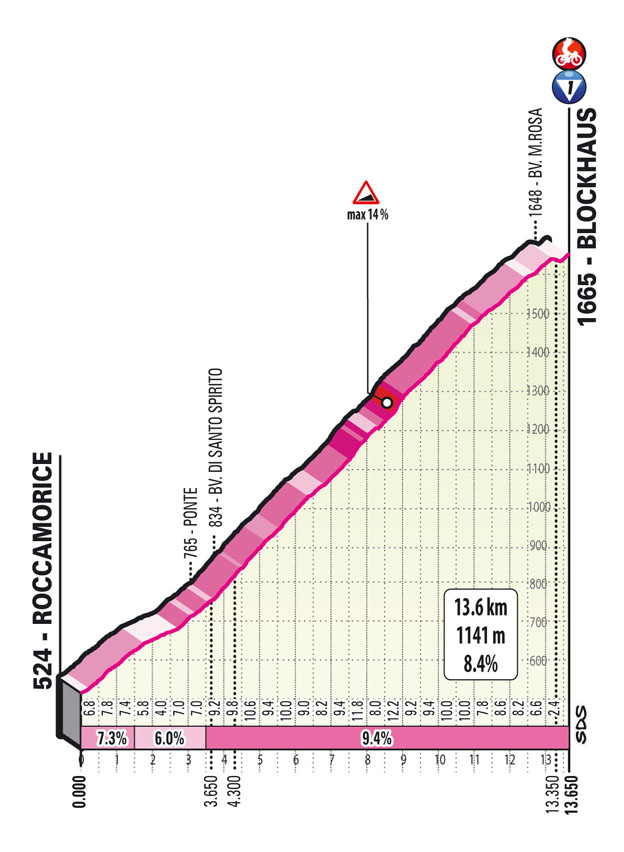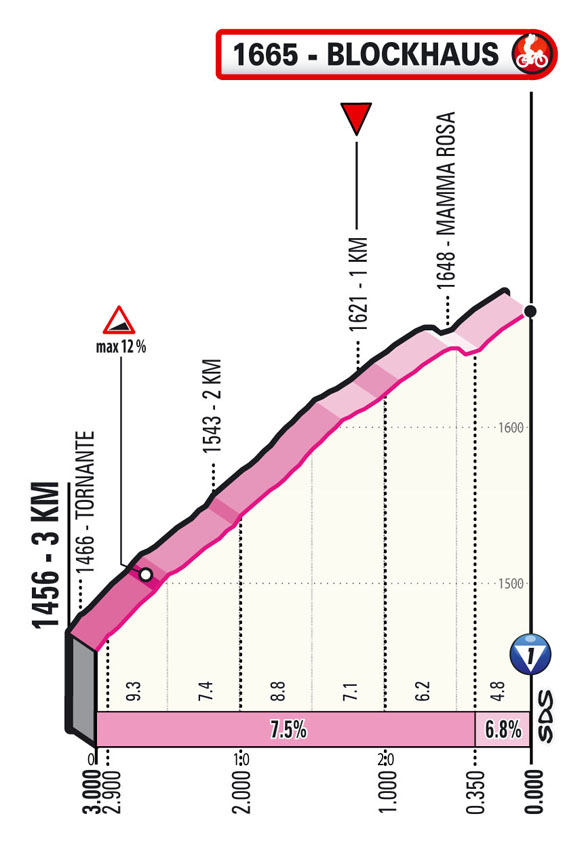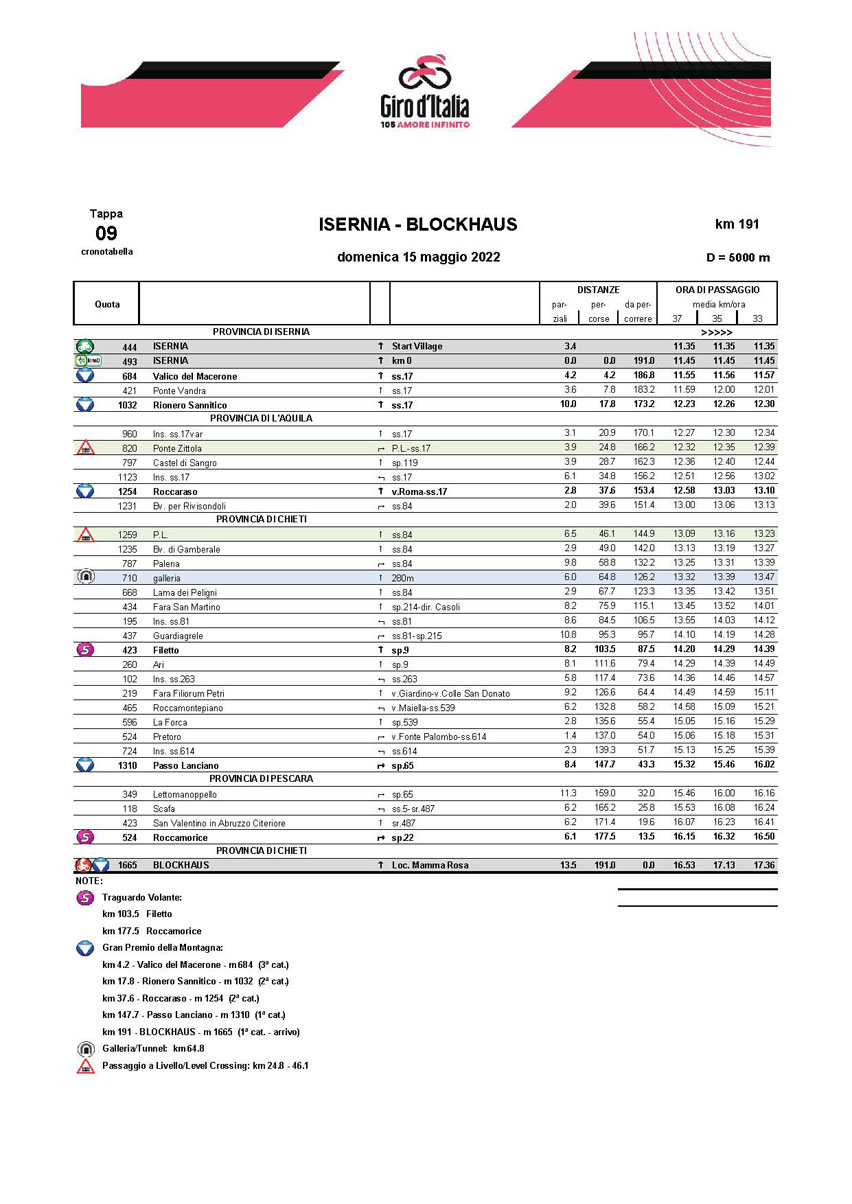profile
map
technical info
The route
A queen stage across the Apennines, with a 5,000 m elevation gain. Shortly after the start, the route clears the Valico del Macerone and the challenging Rionero Sannitico ascent, continuing uphill all the way to Roccaraso. A long undulating descent follows (nearly 90 km), leading to the foot of the first ascent to Passo Lanciano (coming from Pretoro). Next, the route drops into Lettomanoppello, cutting across a few urban areas, and starts to go up again in Scafa. The final climb (13 km) begins past Roccamorice.
Final kilometres
The last 13 km go up steadily on narrow road, with several hairpins. Gradients are over 9% for almost 10 km, with peaks reaching as high as 14%. There is a very short countersloping stretch 500 m before the finish. The home straight (200 m long, on 6-m wide tarmac) has an uphill gradient of approx. 8%.
start / finish
climb detail
final kilometres
itinerary timetable
tourist info
Host city:
Isernia
Touristic Information
Isernia set in a landscape of mountains with snow-capped peaks until the end of April and immersed in the green of its hills, boasts ancient origins dating back to prehistoric times. In fact, at the end of the 70s, of the last century, a prehistoric site of undoubted importance was discovered, allowing to reconstruct the evolutionary dynamics of human groups in the European Pleistocene. The archaeological excavation has brought to light a small piece of our evolutionary history dating back to about 600,000 years ago. In historical times, however, in the first half of the third century. B.C. Rome decides to found a city called Aesernia to start a slow process of Romanization of the Sannio Pentro at that time inhabited, in fact, by the Samnite people. Today the historic center of Isernia, hit several times by earthquakes and wars, still retains many peculiarities, making it unique in some respects: archaeological sites, fountains, squares, alleys, churches and local crafts
Gastronomy
The food and wine tradition of the Province of Isernia and its capital is characterized by simple and genuine dishes of peasant origin. Numerous dairies with centuries-old traditions transform cow, sheep and goat milk producing both fresh and seasoned cheeses, such as the famous stracciata di mozzarella, caciocavallo, manteche, pecorino and ricotta. The territory is rich in truffles, especially the “white prized” one that can be tasted in autumn. The cuisine is rich in dishes based on legumes, among which the beans of Isernia, that of Acquaviva di Isernia, that of Vastogirardi and the lentils of Capracotta stand out for their uniqueness. Among the typical dishes we find pasta alla chitarra, cavatelli with water and flour, potato and flour gnocchi with tomato and pork and pappardelle with wild mushrooms, but the first courses for special occasions are the santè soup and lasagna in capon broth. The main courses range from local meats, especially game, but there is also an ancient tradition in the preparation of cod, typical of Isernia is the one cooked in the so-called “arracanato” style. Among the desserts, the wafers, the rice and wheat pastiera, the calzone stuffed with chickpea cream and cinnamon, the struffoli, the pepatelli, the ferratelle, the castagnole with chocolate and the donuts with naspro are distinguished.
Beverages
The enological identity of Molise is “Tintilia”, a vine rediscovered about 15 years ago, now in the production of rosé, red and red reserves. Tintilia is a native grape of Molise, for centuries considered by the local population to be the grape of qualitative excellence. The Pentro di Isernia wine, red DOC whose production is allowed in the province of Isernia exclusively with Montepulciano and Sangiovese vines, deserves a particular mention. Thanks to the influence of the neighboring regions, we find excellent wines produced such as Falanghina, Trebbiano, Montepulciano and Aglianico.
Finally, with regard to digestive liqueurs, Genziana has been produced for several years in the Province of Isernia, a much loved liqueur of Abruzzese origins that is obtained from a plant that grows on the Apennines above 1000 meters.
Main sights
The city of Isernia with very ancient origins includes one of the most important prehistoric sites in Europe called “La Pineta”. The Paleolithic site, unearthed at the end of the 70s of the last century, has shown its undoubted importance, adding important pieces to reconstruct, in the best possible way, the evolutionary dynamics of human groups of the European Pleistocene. The archaeological area is part of a complex stratigraphic series and extends over an area of about 700 square meters of paleoil. The archaeological excavation, without interruption still in progress, has allowed the recovery of fundamental testimonies relating to our most ancient past, a small piece of our evolutionary history, i.e. ways of life and strategies adopted by groups of Homo heidelbergensis who lived in Isernia in starting at least 600,000 years ago. The archaeological park, which can always be visited, houses a museum which occupies an area of about 4000 square meters where the archaeological finds of the site are given great prominence in the exhibition rooms. The tour is supported by audio and video multimedia materials, transforming the visit into a unique experience. Of exceptional suggestion in the central hall is the faithful reconstruction of a portion of the paleosol with original finds resulting from study and restoration. Otherwise, the historic center of the city preserves a highly respectable historical and archaeological stratification. Through the surviving polygonal and almost square wall partitions it is possible to reconstruct the perimeter and the extension of what must have been the Latin colony of Aesernia founded by Rome in 263 BC. The urban setting of the historic center is strongly influenced by the idea of the city prepared by Roman architects. In fact, in the archaeological excavation below the Cathedral of St. Peter the Apostle, it is possible to visit the remains of a large sacred area, located as usual in the Roman world, at the intersection of the two main axes of the ancient city. The site has two temples of which the oldest (III century BC) is unique, in fact, it is characterized by the imposing podium decorated with a molded frame with a double inverted groove. Furthermore, the historic center of the city preserves the remains of part of a cryptoporticus underground, offering the visitor a tangible cross-section of the life of those times. Even today, despite the destruction following earthquakes and wars, Isernia still has countless strongly characterizing elements such as alleys, squares, noble palaces, churches, fountains; such as the Fontana Fraterna, one of the most beautiful monumental fountains in Italy, attributable to the first half of the 19th century, where decorative stone elements from different eras have been wisely reused, a concrete sign of the historical importance of the city. Also in the ancient village it is absolutely necessary to visit the Archaeological Museum of Santa Maria delle Monache and the Civic.
Blockhaus
Touristic Information
Pretoro, like a lovely crib, is perched on the northeastern slopes of Maiella with a unique appearance, thanks to its stone houses huddled against each other so that they seem “perched” on the steep side of the mountain. Because of its medieval origins, the ancient town centre is characterized by narrow alleys which stop to make way to the suggestive and typical small squares, and by steep stairs that climb up to the highest point of the small village, that is the “Castle”, which offers a wonderful panorama over the surrounding area. Pretoro has kept a typical medieval urban structure, clustered around its highest point where once stood the castle (but nowadays little of it has remained) and radially following the contour lines and steep shape of the rocky terrain. This small village, at around 600 metres above sea level, still preserves all its charm and deserves to be visited slowly, street by street, staircase to staircase, with its romantic and sometimes decadent views, which makes it one of the most evocative places in Abruzzo.
Gastronomy
Among the first courses we can count the “p’ttolozz’” (diamond-shaped pasta made of flour and water) with sauce, once made with a mixture of white flour, cereals and spelt, and the “pasta alla chitarra” of Abruzzo, filaments obtained with a special tool, “lu maccarunar” which is used to give the fresh pasta a square cut and a porous texture that fits well with souce. The “maccarunar” are still built and used in Pretoro.The grilled lamb stands among the second courses. Typical of this dish is the cooking system: in fact, the firewood to cook the meat must be a mixture of wood, from the fir resinous, to the beech free of impurities, to the hornbeam fragrant and to finish branches of Juniper odorous. The salting and the scent must be done with aromatic herbs such as thyme, rosemary, mint, black pepper, red juniper and violet. These are the secrets of an excellent preparation of the pretorese lamb. Other dishes are the “coratella” of lamb and the “turcinelli”, made with the guts of the pig and stuffed with sweetbreads and chili. Among the vegetables we can mention the “ciabbotta”, set of vegetables to be served on slices of homemade bread, and the “pizz’ and foij”, stewed vegetables served with smoked sardine and the “pizza di randinie”, unleavened pizza made with corn flour. Traditionally the “pizza di randinie” is cooked directly on the floor of the fireplace, covered by the “coppo” (a metal lid on which the coal rests), but it will also be very good prepared in the oven or directly in the pan.
Torta del Lupo di Pretoro is a cake made with black chocolate, Montepulciano d’Abruzzo red wine, rum and gianduia. It is a dessert dedicated to Pretoro, a small town of about 850 inhabitants perched on the slopes of the Maiella. Definitely greedy cake, it has a paste generously soaked in rum and an adequate filling of gianduia chocolate.
Beverages
The nose recalls the typical scent of the Pecorino grape, and in the mounth it shows the slight acidity always characteristic of the grape, but well balanced with delicate and very fruity hops, a straw yellow colour, compact and persistent white foam.
This beer is dedicated to the people of Abruzzo. To its landscapes and its products. A new line called “The table of the Brigands”
Main sights
The river Foro flows in the heart of the Maiella National Park and cut through the province of Chieti from Asinara to the Adriatic sea: along its banks, in the river Foro’s Valley, it is possible to notice some ancient mills. In the past, this river represented the unique source of energy and the presence of these mills was the only opportunity for the inhabitants to grind grain and produce different types of flour. To build a mill, it was necessary to comply with some strict laws, and this is the reason why Pretoro, over some centuries, was the protagonist in several legal disputes concerning the ownership of these mills. After the first references to the presence of mills along the river Foro, dating back to the administration by the Benedictine monks of San Salvatore a Maiella.































